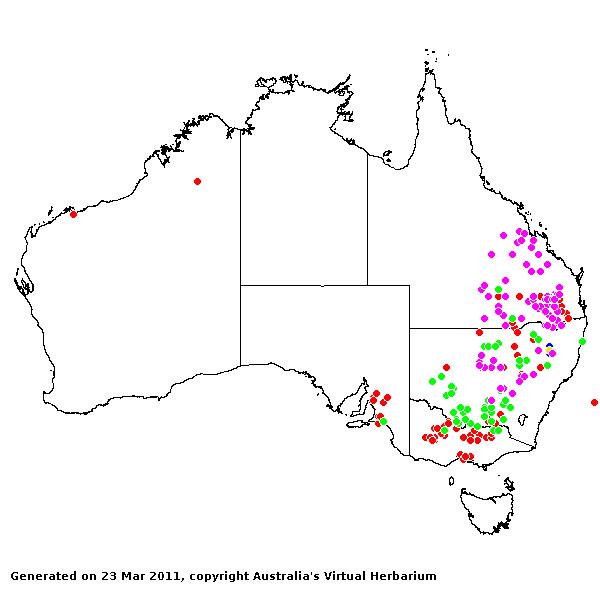Walwhalleya Aust. Syst. Bot. 19: 327 (2006).
Derivation:. Named for R.D.B. Whalley, grassland ecologist from University of New England.
Syn: Whalleya K.E.Wills & J.J.Bruhl.
Key references (keys and floras):. D.Sharp and B.K.Simon, AusGrass (2002); J.P.Jessop, Grasses of South Australia 493–495 as Whalleya (2006) ; S.W.L.Jacobs, R.D.B.Whalley & D.J.B.Wheeler, Grasses of New South Wales, 4th ed, 399–401 (2008)
Native, endemic. 3 species, from Australia. 3 species in Australia, SA, Qld, NSW, and Vic.
Habit. Perennial, rhizomatous (sometimes) or stoloniferous (sometimes). Culms wiry. Leaf blades narrow (tapering to a narrow spine-like apex or acute), not needle-like (apex tapering to a spine or acute). Ligule an unfringed membrane.
Inflorescence. Inflorescence paniculate, an open panicle with branches ending in single spikelets, panicle loose, open. Spikelet-bearing axes falling entire.
Spikelets. Spikelets dorsally compressed, 2 flowered, with 1 fertile floret, not markedly hairy, solitary, pedicelled; with rachilla terminating in a floret. Fertile spikelets with lower incomplete floret(s), elliptic or lanceolate, dorsally compressed, falling with glumes.
Glumes. Glumes unequal (the lower 3/4 length of the upper), about equal to spikelet (upper), long relative to adjacent lemmas, hairless, scabrous, pointed (acute) or rounded, awnless, non-keeled, similar. Lower glume 3–7 nerved. Upper glume 7–9 nerved.
Florets. Lower incomplete floret(s) sterile. Lemmas similar to upper glume, exceeding fertile lemmas. Fertile florets 1. Lemmas similar in texture to glumes, entire at apex, pointed, muticous, not keeled. Palea relatively long, apically notched, textured like lemma. Lodicules 2. Stamens 3. Stigmas 2.
Kranz Anatomy. C3.
Habitat. Mesophytic, xerophytic. Shade species, or species of open habitats.
Classification. Panicoideae; Paniceae.
Notes. Distinctive features include a notched upper palea apex, with a central depression; very finely muricate upper palea and upper lemma clearly visible at high power magnification (x 50); pronounced and raised nerves on the lower lemma; lower glume 60–90% of spikelet length. It includes three species endemic to Australia (Wills, Whalley and Bruhl, 2000).
Types Species. W. pungens (K.E.Wills & J.J.Bruhl) K.E.Wills & J.J.Bruhl.
Biogeographic Element. Clifford & Simon 1981, Simon & Jacobs 1990: Endemic.


